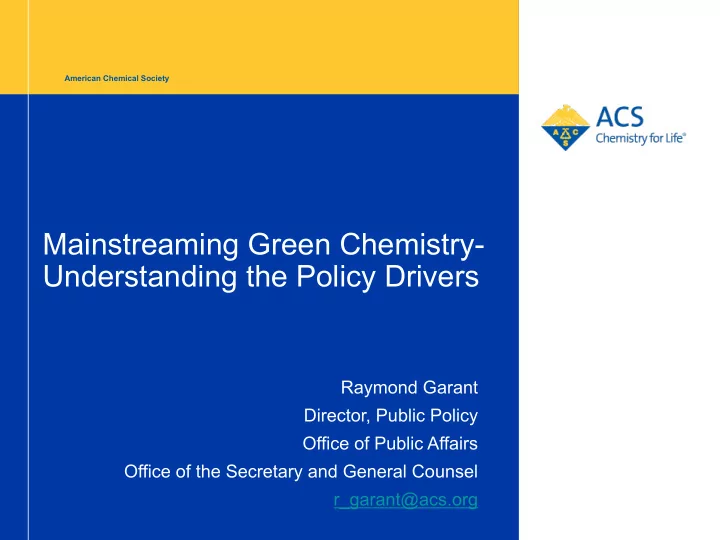

American Chemical Society Mainstreaming Green Chemistry- Understanding the Policy Drivers Raymond Garant Director, Public Policy Office of Public Affairs Office of the Secretary and General Counsel r_garant@acs.org
History of Green Chemistry Policy 1990— Pollution Prevention Act becomes law and starts series of EPA voluntary programs, research activities, and cooperative agreements in “alternative synthetic pathways 1995—Presidential Green Chemistry Challenge Awards established 1997—GCI established (joined ACS in 2001) and OECD and IUPAC begin green chemistry discussions 2001— Small Business Pollution Prevention Act proposes incentives for greening of dry cleaning chemicals and Massachusetts considers tax incentives for green chemistry R&D 2004—multi-faceted Green Chemistry R&D legislation first introduced in Congress 2008—California establishes Green Chemistry Initiative 2010—Congress adopts green chemistry language in COMPETES American Chemical Society 2
Sustainable Chemistry at the National Science Foundation • Green chemistry language included in a S&T reauthorization law in 2010 (COMPETES) • Science, Engineering, and Education for Sustainability (SEES) program funded at $23 in FY 2015 • Expected to sunset in 2017 • SEES Postdoctoral Fellows Program – discontinued • Sustainable Chemistry, Engineering, and Materials (SusChEM) research program receives majority of funding leftover from SEES.
Policy Drivers • Workforce • Regulation • Coordination • Research support • Data Collection • Manufacturing centers • Awards and Prizes • Scale-up support • Alternatives development • Voluntary programs • Preferential purchasing • Standards • Incentives (e.g., tax, regulatory) American Chemical Society 4
Policy Issues • Green chemistry v. Sustainable chemistry • Regulation (Toxic Use Reduction) v. Technology (Innovation) • Mandatory v. Voluntary • Federal v. State (v. International) • Banning certain chemical use v. Alternatives development • Burden of Proof and changes in chemicals testing (toxicology) American Chemical Society 5
Frank Lautenberg Chemical Safety for the 21 st Century Act (S.697) • Bipartisan TSCA reauthorization proposed by Senators David Vitter (R- LA) and Tom Udall (D-NM) • Once-in-a-decade window to repair a law that has been flawed since its introduction in 1976 • Major political struggle in progress • Contains a sustainable chemistry R&D section on which ACS and GC3 have worked closely with Senator Chris Coons (D-DE) – Creates a presidential council to coordinate research between federal agencies – Expands support for green and sustainable chemistry within the federal government, including public private partnerships – Request a broad federal study of sustainable chemistry to needs and challenges • Sustainable Chemistry R&D Act (S.2879 in 2014 ) not yet introduced American Chemical Society 6
Discussion Raymond Garant Director, Public Policy Office of Public Affairs Office of the Secretary and General Counsel r_garant@acs.org American Chemical Society 7
Sustainable Chemistry R&D Act (2014 )
Recommend
More recommend